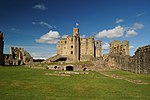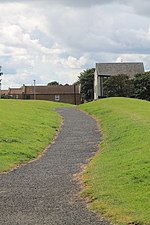Warkworth, Northumberland

Warkworth is a village in Northumberland, England. It is probably best known for its well-preserved medieval castle, church and hermitage. The population of Warkworth was 1,493 in 2001, increasing to 1,574 at the 2011 Census. The village is situated in a loop of the River Coquet, about 1 mile (1.6 km) from the Northumberland coast and lies on the main A1068 road. It is 30 miles (48 km) north of Newcastle, and about 40 miles (64 km) south of the Scottish border. An ancient bridge of two arches crosses the river at Warkworth, with a fortified gateway on the road mounting to the castle, the site of which is surrounded on three sides by the river. Warkworth is popular with visitors for its old buildings, its walks by the River Coquet, and its proximity to the Northumberland Coast, an Area of Outstanding Natural Beauty (AONB). It is twinned with Warkworth, New Zealand, which is named after it.
Excerpt from the Wikipedia article Warkworth, Northumberland (License: CC BY-SA 3.0, Authors, Images).Warkworth, Northumberland
Die Trift, Nesseaue
Geographical coordinates (GPS) Address Nearby Places Show on map
Geographical coordinates (GPS)
| Latitude | Longitude |
|---|---|
| N 55.345 ° | E -1.611 ° |
Address
Sieben Gräber
Die Trift
99869 Nesseaue
Thüringen, Deutschland
Open on Google Maps










